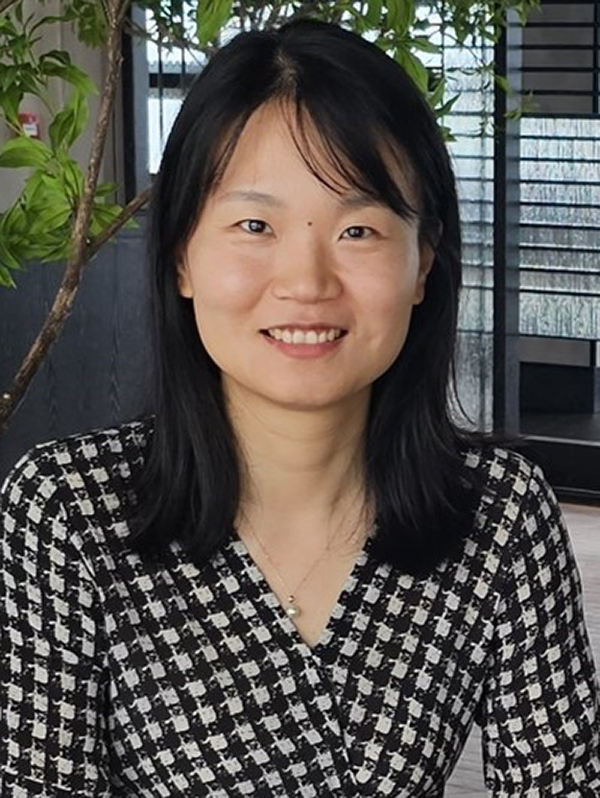- 1B-103, 1/F, Block 1, To Yuen Building
- +852 3442-2494
- +852 3442-0549
- wenjun.xiong@cityu.edu.hk
- CityU Scholars
- Lab Website
- Photoreceptor cells • Retinal degeneration diseases • Gene therapy • Regenerative medicine
Prof. Xiong earned her PhD in Biomedical Sciences from the University of Chicago in 2010, where she worked under the guidance of Prof. Ilaria Rebay to investigate the spatiotemporal coordination of signaling pathways during Drosophila compound eye development. In 2011, she joined Prof. Constance Cepko’s lab at Harvard Medical School for postdoctoral research training, focusing on the mechanisms of inherited blindness and developing gene therapies to preserve vision in preclinical models. She established her independent research group at the City University of Hong Kong in 2015 as an Assistant Professor and was promoted to Associate Professor in 2021.
Research Interests
Vision is our most critical sense, enabling perception of the world through photoreceptors-specialized retinal neurons that convert light into neural signals. However, these cells are highly susceptible to degeneration in diseases such as Retinitis Pigmentosa, which is a severe inherited disorder, and Age-related Macular Degeneration, the leading cause of blindness in the elderly. Our lab seeks to decipher molecular mechanisms that enable photoreceptor rescue, replacement, or regeneration in degenerative conditions. We aim to translate discoveries from animal models into gene and regenerative therapies for patients.
Current Focus Areas
- Gene Therapy Development – Designing adeno-associated virus (AAV)- and lipid-nanoparticle (LNP)-based gene therapy, gene editing, and regenerative therapy for retinal degenerative diseases.
- High Myopia Research – Investigating disease mechanisms and therapeutic interventions for myopia.



Position Availability
We are looking for talented people to join our team.
- PhD positions are available. Candidates who have a strong interest in our research and meet the basic requirements of the University and BMS department are encouraged to apply. Interested candidates can send CV and a short summary of past research experience to Prof. Xiong (wenjun.xiong@cityu.edu.hk).
- Postdoctoral fellow and Research Assistant positions are available upon enquiry. Interested candidates can send CV and a short summary of past research experience to Prof. Xiong (wenjun.xiong@cityu.edu.hk).
- Undergraduate students who seek for lab experience are welcome to contact Prof. Xiong directly by email, phone or office visit.
Selected Publications
- Wu Z.#, Liao B.#, Ying J., Keung J., Zheng Z., Ahola V., Xiong W. Simultaneous cyclin D1 overexpression and p27kip1 knockdown enable robust Müller glia cell cycle reactivation in uninjured mouse retina. eLife. 2025 Apr 3;13:RP100904. (#Co-first authors)
- Hoang D, Liao B, Zheng Z, Xiong W. Mutation-independent gene knock-in therapy targeting 5’UTR for autosomal dominant retinitis pigmentosa. Signal Transduction and Targeted Therapy. 2023 Mar 8;8(1):100.
- Mai S, Zhu X, Wan EYC, Wu S, Yonathan JN, Wang J, Li Y, Ma JYW, Zuo B, Tse DY, Lo PC, Wang X, Chan KM, Wu DM, Xiong W. Postnatal eye size in mice is controlled by SREBP2-mediated transcriptional repression of Lrp2 and Bmp2. Development. 2022 Jul 15;149(14):dev200633.
- Zhang X, Zhang BW, Xiang L, Wu H, Alexander SAS, Zhou P, Dai MZ, Wang X, Xiong W, Zhang Y, Jin ZB, Deng LW. MLL5 is involved in retinal photoreceptor maturation through facilitating CRX-mediated photoreceptor gene transactivation. iScience. 2022 Mar 11;25(4):104058.
- Wu DM, Ji X, Ivanchenko MV, Chung M, Piper M, Rana P, Wang SK, Xue Y, West E, Zhao SR, Xu H, Cicconet M, Xiong W, Cepko CL. Nrf2 overexpression rescues the RPE in mouse models of retinitis pigmentosa. JCI Insight. 2021 Jan 25;6(2):e145029.
- Feng, T., Mai. S., Roscoe. JM., Sheng. RR., Ullah, M., Zhang J., Katz, II., Yu, H., Xiong, W., Hu, F. Loss of TMEM106B and PGRN leads to severe lysosomal abnormalities and neurodegeneration in mice. EMBO reports. 2020 Oct 5; 21(10):e50219.
- Tan, Y., Chu, AHY., Bao, S., Hoang, DA., Kebede, FT., Xiong, W., Ji, M., Shi, J., Zheng, Z. Rationally engineered Staphylococcus aureus Cas9 nucleases with high genome-wide specificity. Proc Natl Acad Sci U S A. 2019 Oct 15;116(42):20969-20976.
- Xiong, W. #*, Wu DM.#, Xue Y.#, Wang SK., Chung MJ., Ji X., Rana P., Zhao SR., Mai S., and Cepko CL*. "AAV cis-regulatory sequences are correlated with ocular toxicity". PNAS. 2019, 116 (12): 5785-5794. (#Co-first authors; *Co-corresponding authors) https://www.pnas.org/content/116/12/5785.long
- Xiong, W., Garfinkel, A., Li, Y., Benowitz, L., and Cepko, C.
Nrf2 promotes neuron survival in neurodegeneration and acute nerve damage
. Journal of Clinical Investigation, 2015, 125(4):1433-45. http://www.jci.org/articles/view/79735 - Xiong, W. and Cepko, C.
Distinct expression patterns of AAV8 vectors with broadly active promoters from subretinal injections of neonatal mouse eyes at two different ages
. In: Westendorf, S., LaVail, M., Bowes, R. eds. Retinal degeneration. New York: Springer; 2015. In press. (Book Chapter) PDF file is available here. - Punzo, C., Xiong, W. and Cepko, C.L.
Loss of daylight vision in retinal degeneration: are oxidative stress and metabolic dysregulation to blame?
Review. Journal of Biological Chemistry, 2012, 287(3):1642-8.
29 April 2025
